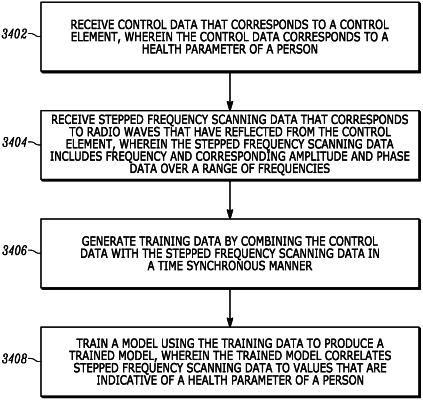| CPC A61B 5/02108 (2013.01) [A61B 5/05 (2013.01); A61B 5/7267 (2013.01); H01Q 1/273 (2013.01); H01Q 21/24 (2013.01)] | 15 Claims |

|
1. A computer-implemented method for use in monitoring a health parameter, the method comprising:
receiving a pulse wave signal that is generated from radio frequency scanning data that corresponds to radio waves that have reflected from below the skin surface of a person,
wherein the radio frequency scanning data is collected through a two-dimensional array of receive antennas over a range of radio frequencies;
extracting features from at least one of the pulse wave signal and a mathematical model generated in response to the pulse wave signal;
labeling the features extracted from at least one of the pulse wave signal and the mathematical model generated in response to the pulse wave signal, with time-synchronized corresponding blood pressure information;
using the labeled features extracted from at least one of the pulse wave signal and the mathematical model generated in response to the pulse wave signal as ground truths to generate training data,
wherein the time-synchronized corresponding blood pressure information is obtained from blood pressure measurements via a catheter or a sphygmomanometer;
extracting features, as a function of time, from a publicly available digital dataset of pulse pressure waveforms and blood pressure data;
labeling the features extracted from the publicly available digital dataset of pulse pressure waveforms and blood pressure data, with time-synchronized corresponding blood pressure information;
using the labeled features extracted from the publicly available digital dataset of pulse pressure waveforms and blood pressure data as ground truths to generate supplemental training data;
training a machine learning model using the training data and the supplemental training data to produce a trained machine learning model, wherein the trained machine learning model correlates 1) the labeled features extracted from at least one of the pulse wave signal and the mathematical model generated in response to the pulse wave signal, and 2) the labeled features extracted from the publicly available digital dataset of pulse pressure waveforms and blood pressure data,
wherein
the training of the machine learning model comprises weighting the training data generated from the radio frequency scanning data more heavily than the supplemental training data generated from the publicly available digital dataset; and
utilizing the trained machine learning model, implementing an inference operation to generate values that are indicative of blood pressure in response to the extracting features from at least one of the pulse wave signal and a mathematical model generated in response to the pulse wave signal.
|